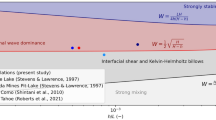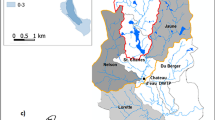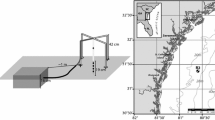Abstract
The influence of sediments in the heat budget of water bodies has been reported to be determinant in shallow lakes and wetlands, whereas it is usually neglected in larger water bodies. In this article, we address the question of whether or not sediments should be considered in the computation of water temperature, by defining two dimensionless numbers that describe the thermodynamics regimes of shallow lakes and wetlands. These dimensionless numbers rise from the analysis of the role of periodic heat exchanges at the sediment–water interface (SWI) on the water temperature of shallow lakes and wetlands. The analysis was based on the derivation of an analytic solution that adopts the solution for the second Stokes problem for computing the sediment temperature, when the system is forced by periodic (diurnal, seasonal, decadal) heat exchanges with the atmosphere. The first dimensionless number is the ratio between the thermal inertia of the active sediments and the thermal inertia of the water column, and quantifies the role of sediments on the heat budget. The second dimensionless number, on the other hand, is defined as the ratio between the timescale of changes in the external forcing and the timescale required to reach the heat equilibrium at the SWI, and characterizes the influence of turbulence on the water column on heat exchanges across the SWI. We complemented the analysis with field observations conducted in shallow lakes of 5–15 cm depth, whose thermodynamics is controlled by heat exchanges between the water column and the sediments. As the dimensionless numbers defined here are frequency dependent, we show that one particular process can be neglected for one specific frequency, while it cannot be neglected for other frequencies. In the case of lakes and deep wetlands, sediments could be neglected in a diurnal time-scale, while they should be included for seasonal or decadal time-scales. The relevance of this frequency-dependence is that it suggests that sediments should always be considered in long-term climatic simulations.








Similar content being viewed by others

References
Batchelor GK (1967) An introduction to fluid dynamics. Cambridge University Press, Cambridge
Bogan T, Mohsemi O, Stefan HG (2003) Stream temperature-equilibrium temperature relationship. Water Resour Res 39:1243
de la Fuente A (2014) Heat and dissolved oxygen exchanges between the sediment and water column in a shallow salty lagoon. J Geophys Res Biogeosciences 119:596–613
de la Fuente A, Niño Y (2010) Temporal and spatial features of the thermohydrodynamics of shallow salty lagoons in northern Chile. Limnol Oceanogr 55:279–288. doi:10.4319/lo.2010.55.1.0279
de la Fuente A, Ordóñez C, Pérez R (2016) Diffusional mass transfer coefficient at the water–sediment interface for wind-induced flow in very shallow lagoons. Environ Fluid Mech 16:539–558. doi:10.1007/s10652-015-9437-9
Fang X, Stefan HG (1998) Temperature variability in lake sediments. Water Resour Res 34:717–729
Fischer H, List R, Imberger J, Brooks N (1979) Mixing in island and coastal waters. Academic Press, London
Garratt JR (1992) The atmospheric boundary layer. Cambridge University Press, Cambridge
Hipsey MR, Sivapalan M, Clement TP (2004) A numerical and field investigation of surface heat fluxes from small wind-sheltered waterbodies in semi-arid Western Australia. Environ Fluid Mech 4:79–106. doi:10.1023/A:1025547707198
Hondzo M, Stefan HG (1994) Riverbed heat conduction prediction. Water Resour Res 30:1503–1513. doi:10.1029/93WR03508
Imberger J (1998) Flux path in a stratified lake: a review. In: Imberger J (ed) Physical processes in Lakes and Oceans. American Geophysical Union, Washington, DC, pp 1–17
Imberger J (2013) Environmental fluid dynamics: flow processes, scaling, equations of motion, and solutions to environmental flows. Academic Press, London
Le PM, Papavassiliou DV (2006) Turbulent heat transfer in plane couette flow. J Heat Transfer 128:53. doi:10.1115/1.2130404
MacKay MD, Neale PJ, Arp CD, De Senerpont Domis LN, Fang X, Gal G, Jöhnk KD, Kirillin G, Lenters JD, Litchman E, MacIntyre S, Marsh P, Melack J, Mooij WM, Peeters F, Quesada A, Schladow SG, Schmid M, Spence C, Stokesr SL (2009) Modeling lakes and reservoirs in the climate system. Limnol Oceanogr 54:2315–2329. doi:10.4319/lo.2009.54.6_part_2.2315
Martynenko OG, Khramtsov PP (2005) Free-convective heat transfer: with many photographs of flows and heat exchange. Springer, Berlin
McCabe RM, Estrade P, Middleton JH, Melville WK, Roughan M, Lenain L (2010) Temperature variability in a shallow, tidally isolated coral reef lagoon. J Geophys Res 115:C12011. doi:10.1029/2009JC006023
McJannet D, Cook F, McGloin R, McGowan H, Burn S, Sherman B (2013) Long-term energy flux measurements over an irrigation water storage using scintillometry. Agric For Meteorol 168:93–107. doi:10.1016/j.agrformet.2012.08.013
Necati O (1977) Basic heat transfer. McGraw-Hill, New York
Patankar S (1980) Numerical heath transfer and fluid flow. Hemisphere Publishing Corporation, Washington, DC
Prats J, Ramos A, Armengol J, Dolz J (2011) Comparison of models for calculation of diel sediment–water heat flux from water temperatures. J Hydraul Eng 137:1135–1147. doi:10.1061/(ASCE)HY.1943-7900.0000434
Shintani T, de la Fuente A, Niño Y, Imberger J (2010) Generalizations of the Wedderburn number: parameterizing upwelling in stratified lakes. Limnol Oceanogr 55:1377–1389
Silva CP, Marti CL, Imberger J (2014) Horizontal transport, mixing and retention in a large, shallow estuary: Río de la Plata. Environ Fluid Mech 14:1173–1197. doi:10.1007/s10652-013-9330-3
Smith NP (2002) Observations and simulations of water–sediment heat exchange in a shallow coastal lagoon. Estuaries 25:483–487. doi:10.1007/BF02695989
Spigel R, Imberger J (1980) The classification of mixed-layer dynamics in lakes of small to medium size. J Phys Ocean 10:1104–1121
Stull RB (1999) An introduction to boudary layer meteorology. Kluwer Academic Publishers, Dordrecht
Versteeg HK, Malalasekera W (1995) An introduction to computational fluid dynamics. The finite volume methods. Longman Group Ltd., Harlow
Wetzel RG (2001) Limnology: lake and river ecosystems. Academic Press, London
Acknowledgements
This study was financed by the Fondecyt project number 1140821.
Author information
Authors and Affiliations
Corresponding author
Rights and permissions
About this article
Cite this article
de la Fuente, A., Meruane, C. Dimensionless numbers for classifying the thermodynamics regimes that determine water temperature in shallow lakes and wetlands. Environ Fluid Mech 17, 1081–1098 (2017). https://doi.org/10.1007/s10652-017-9536-x
Received:
Accepted:
Published:
Issue Date:
DOI: https://doi.org/10.1007/s10652-017-9536-x



